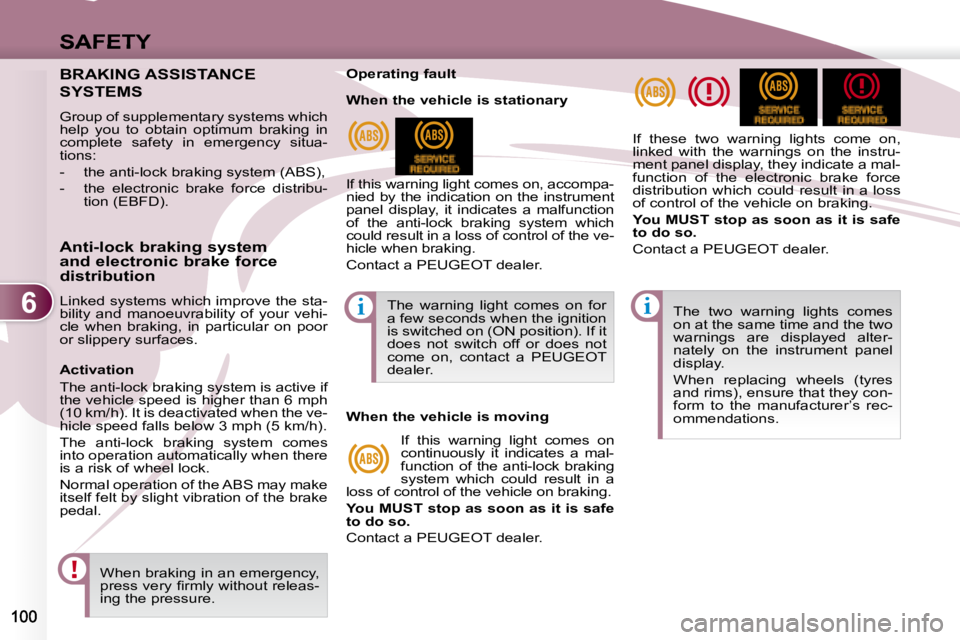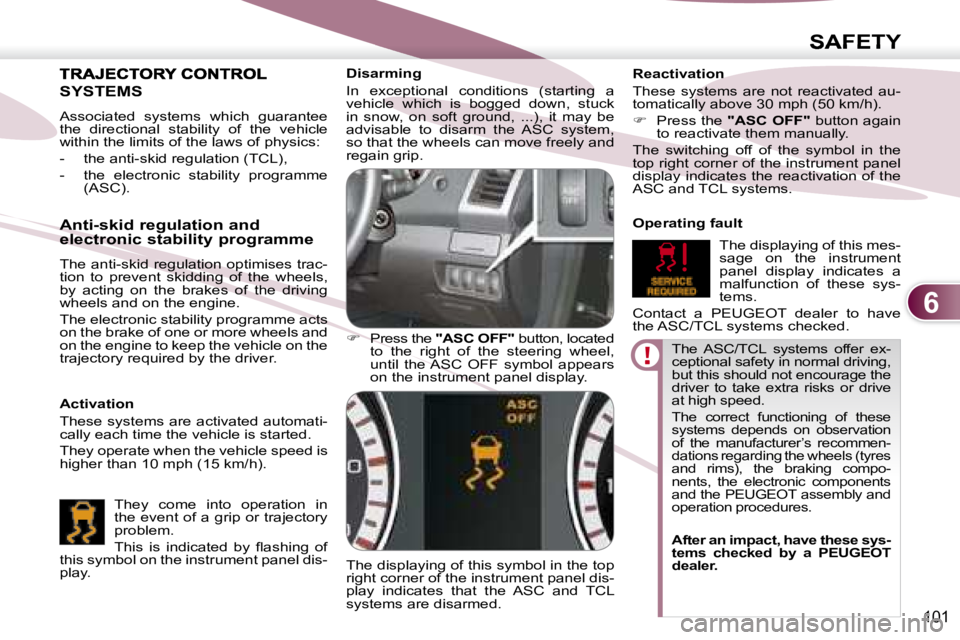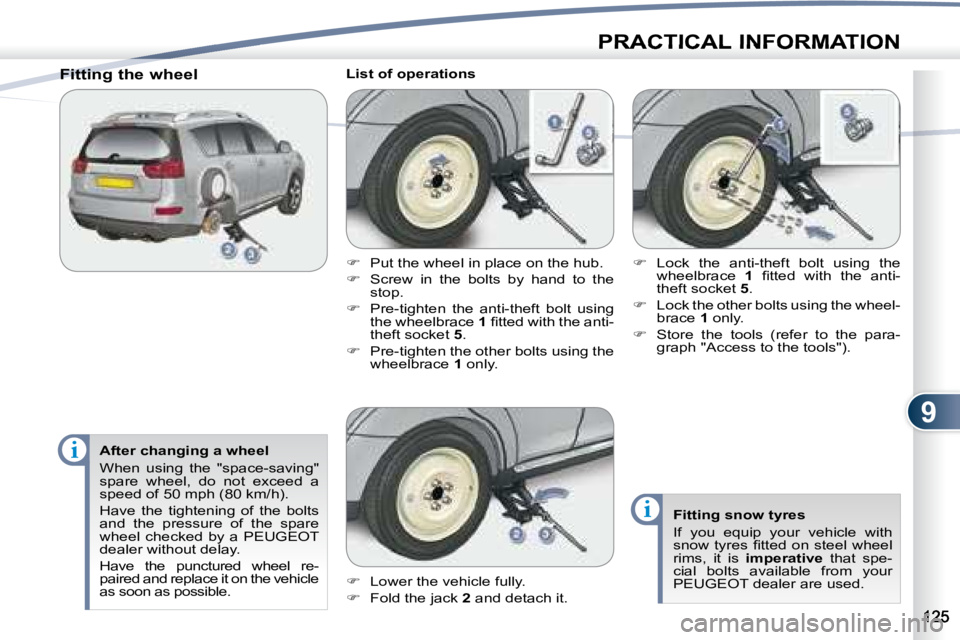Page 110 of 221

6ii
SAFETY
BRAKING ASSISTANCE
SYSTEMS
Group of supplementary systems which
help you to obtain optimum braking in
complete safety in emergency situa-
tions:
- the anti-lock braking system (ABS),
- the electronic brake force distribu-tion (EBFD).
Anti-lock braking system
and electronic brake force
distribution
Linked systems which improve the sta-
bility and manoeuvrability of your vehi-
cle when braking, in particular on poor
or slippery surfaces.
When braking in an emergency,
�p�r�e�s�s� �v�e�r�y� �fi� �r�m�l�y� �w�i�t�h�o�u�t� �r�e�l�e�a�s�-
ing the pressure. The two warning lights comes
on at the same time and the two
warnings are displayed alter-
nately on the instrument panel
display.
When replacing wheels (tyres
and rims), ensure that they con-
form to the manufacturer’s rec-
ommendations.
Operating fault
If this warning light comes on, accompa-
nied by the indication on the instrument
panel display, it indicates a malfunction
of the anti-lock braking system which
could result in a loss of control of the ve-
hicle when braking.
Contact a PEUGEOT dealer.
If these two warning lights come on,
linked with the warnings on the instru-
ment panel display, they indicate a mal-
function of the electronic brake force
distribution which could result in a loss
of control of the vehicle on braking.
You MUST stop as soon as it is safe
to do so.
Contact a PEUGEOT dealer.
Activation
The anti-lock braking system is active if
the vehicle speed is higher than 6 mph
(10 km/h). It is deactivated when the ve-
hicle speed falls below 3 mph (5 km/h).
The anti-lock braking system comes
into operation automatically when there
is a risk of wheel lock.
Normal operation of the ABS may make
itself felt by slight vibration of the brake
pedal. The warning light comes on for
a few seconds when the ignition
is switched on (ON position). If it
does not switch off or does not
come on, contact a PEUGEOT
dealer.
When the vehicle is stationary
When the vehicle is moving
If this warning light comes on
continuously it indicates a mal-
function of the anti-lock braking
system which could result in a
loss of control of the vehicle on braking.
You MUST stop as soon as it is safe
to do so.
Contact a PEUGEOT dealer.
Page 111 of 221

6
SAFETY
101
The ASC/TCL systems offer ex-
ceptional safety in normal driving,
but this should not encourage the
driver to take extra risks or drive
at high speed.
The correct functioning of these
systems depends on observation
of the manufacturer’s recommen-
dations regarding the wheels (tyres
and rims), the braking compo-
nents, the electronic components
and the PEUGEOT assembly and
operation procedures.
After an impact, have these sys-
tems checked by a PEUGEOT
dealer.
Disarming
In exceptional conditions (starting a
vehicle which is bogged down, stuck
in snow, on soft ground, ...), it may be
advisable to disarm the ASC system,
so that the wheels can move freely and
regain grip.
� Press the "ASC OFF" button, located
to the right of the steering wheel,
until the ASC OFF symbol appears
on the instrument panel display.
The displaying of this symbol in the top
right corner of the instrument panel dis-
play indicates that the ASC and TCL
systems are disarmed. Reactivation
These systems are not reactivated au-
tomatically above 30 mph (50 km/h).
� Press the "ASC OFF" button again
to reactivate them manually.
The switching off of the symbol in the
top right corner of the instrument panel
display indicates the reactivation of the
ASC and TCL systems.
Operating fault
The displaying of this mes-
sage on the instrument
panel display indicates a
malfunction of these sys-
tems.
Contact a PEUGEOT dealer to have
the ASC/TCL systems checked.
SYSTEMS
Associated systems which guarantee
the directional stability of the vehicle
within the limits of the laws of physics:
- the anti-skid regulation (TCL),
- the electronic stability programme (ASC).
Activation
These systems are activated automati-
cally each time the vehicle is started.
They operate when the vehicle speed is
higher than 10 mph (15 km/h).
Anti-skid regulation and
electronic stability programme
The anti-skid regulation optimises trac-
tion to prevent skidding of the wheels,
by acting on the brakes of the driving
wheels and on the engine.
The electronic stability programme acts
on the brake of one or more wheels and
on the engine to keep the vehicle on the
trajectory required by the driver.
They come into operation in
the event of a grip or trajectory
problem.
� �T�h�i�s� �i�s� �i�n�d�i�c�a�t�e�d� �b�y� �fl� �a�s�h�i�n�g� �o�f�
this symbol on the instrument panel dis-
play.
Page 136 of 221

9
i
i
PRACTICAL INFORMATION
After changing a wheel
When using the "space-saving"
�s�p�a�r�e� �w�h�e�e�l�,� �d�o� �n�o�t� �e�x�c�e�e�d� �a�
speed of 50 mph (80 km/h).
Have the tightening of the bolts
and the pressure of the spare
wheel checked by a PEUGEOT
dealer without delay.
Have the punctured wheel re-
paired and replace it on the vehicle
as soon as possible.
Fitting the wheel
List of operations
� Lower the vehicle fully.
� Fold the jack 2 and detach it.
� Lock the anti-theft bolt using the
wheelbrace 1� � �fi� �t�t�e�d� �w�i�t�h� �t�h�e� �a�n�t�i�-
theft socket 5 .
� Lock the other bolts using the wheel-
brace 1 only.
� Store the tools (refer to the para-
graph "Access to the tools").
Fitting snow tyres
If you equip your vehicle with
�s�n�o�w� �t�y�r�e�s� �fi� �t�t�e�d� �o�n� �s�t�e�e�l� �w�h�e�e�l�
rims, it is imperative that spe-
cial bolts available from your
PEUGEOT dealer are used.
� Put the wheel in place on the hub.
� Screw in the bolts by hand to the
stop.
� Pre-tighten the anti-theft bolt using
the wheelbrace 1� � �fi� �t�t�e�d� �w�i�t�h� �t�h�e� �a�n�t�i�-
theft socket 5 .
� Pre-tighten the other bolts using the
wheelbrace 1 only.